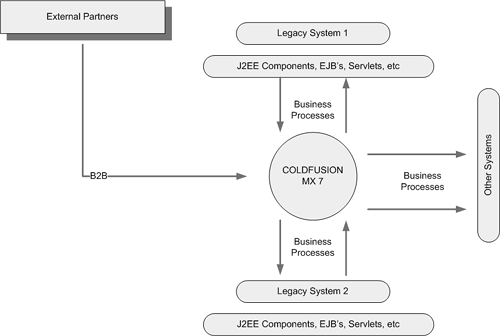Benefits of Deploying ColdFusion on J2EE Application Server
| There are many benefits of scaling ColdFusion onto a J2EE platform. Whether ColdFusion is deployed on the Macromedia JRun, Sun ONE, IBM WebSphere, BEA WebLogic, or another J2EE application server, you will benefit. ColdFusion MX 7 supports standards-based J2EE and inherits many capabilities from the underlying Java application server. It can support legacy infrastructure and enhance prior technology investments. This section and the next discuss many of these benefits. Standards-BasedSince ColdFusion MX 7 is based on a well defined, well accepted, and strongly supported set of standards with a large vendor base you have far more options available to you than developers on other platforms. As a ColdFusion developer you are not stuck to a specific J2EE vendor or operating system. ColdFusion MX 7 works on the major commercial J2EE servers as well as it can work with open source J2EE servers. ColdFusion MX 7 inherits Java's multiplatform support and works with every major operating system platform out there. Java's wide support and conformance to standards guarantee's that ColdFusion developers will always have the freedom to choose the solutions that work best for them. Not only which J2EE platform to use or which operating system, but which Database, which Web Server, which messaging system, or anything else they wish to use. Multiple PlatformsThere are now several ways to install your ColdFusion MX 7 Server. ColdFusion MX 7 now comes in three instillation varieties: ColdFusion MX 7 Standalone, ColdFusion MX 7 Multiserver, and ColdFusion MX for J2EE Application Server. These installation options are explained below as well as each of the major supported servers:
While the above installations and installations types reference all the supported ways to install ColdFusion MX 7 it is possible to install ColdFusion MX 7 on J2EE servers others than those listed here but Macromedia will not provide support or any guarantees for any but the above J2EE servers. If you are interested in getting more information on installing ColdFusion MX 7 on unsupported J2EE servers such as Tomcat or JBoss, or would like more up to date and extensive information on ColdFusion MX 7 support for J2EE platforms you can always find the latest information at http://www.macromedia.com/support/coldfusion/j2ee/cfmx7j2ee_home.html. Support for Legacy Infrastructure and Prior InvestmentsMost organizations have legacy infrastructure and have invested tremendous capital in building, deploying, and maintaining this infrastructure. Seldom does a CIO or CTO want to scrap these systems and perform complete overhauls of existing architectures. They merely want to improve upon these structures, provide better operability between disparate enterprise systems, and implement new features. They also want to develop these new applications utilizing standards-based tools. ColdFusion allows developers and application architects to build applications that extend the enterprise and enhance existing functionality. ColdFusion code can use existing application servers, components, Enterprise Java Beans (EJBs), and even existing JSP templates. Via its new gateway functionality, ColdFusion MX 7 now can also work with a variety of messaging technologies such as JMS (Java Message Service) and MQ Series. The gateway feature allows you to integrate much more easily with new and legacy enterprise resource planning (ERP) applications such as SAP. Integrating these systems can be accomplished by implementing ColdFusion applications, which push and pull data between disconnected systems. Data integrity is maintained by using components that have the application's business logic and database connectivity in place. This allows organizations to leverage existing systems, adding more capabilities to these systems without rebuilding from scratch. See Figure 4.1 for an illustration of leveraging existing applications and providing application integration. Figure 4.1. ColdFusion can provide application integration and leverage existing systems and applications. Potential uses for ColdFusion in an enterprise include the following:
Inheritance of Multiplatform InteroperabilityBecause ColdFusion MX 7 is built on J2EE technology, the components of any application built using standards-based Java architecture are available to ColdFusion MX 7. In addition, Cold Fusion MX 7 can potentially work with any existing infrastructure that supports Java within the enterprise. This makes ColdFusion a versatile tool for developers to use in solving common business problems, while providing methods for developing applications that can be run in many different environments. Developers who use ColdFusion will not have to change tools in order to code on different platforms such as .NET and J2EE, and will be able to deploy Web applications on HP-UX, AIX, Linux, Solaris, and Windows. |
EAN: 2147483647
Pages: 240